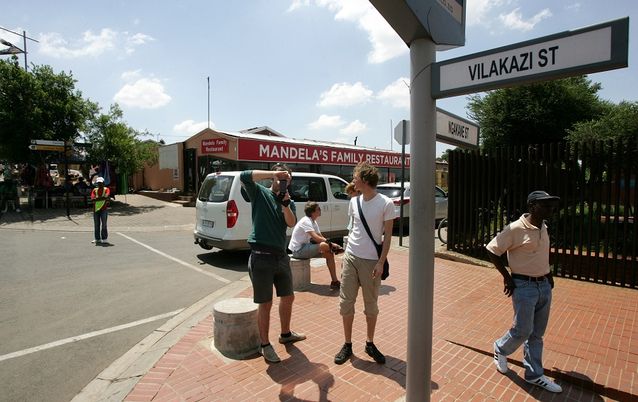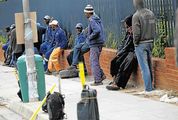ON MOST days, especially weekends, Soweto’s Vilakazi Street is teeming with tourists, both foreign and local, keen to soak in the atmosphere and sample the local cuisine.
Vilakazi Street still has the distinction of being the only road on which two Nobel laureates once lived.
The street has attracted substantial funding from the Johannesburg Development Agency (JDA), which worked with the local community to develop a Freedom Walk, encompassing Nelson Mandela’s former house (now a museum), Archbishop Desmond Tutu’s home, the Hector Peterson Memorial and several schools that were the centre of the 1976 Soweto uprising.
However, 4.5km away in another section of Soweto, is Kliptown’s Walter Sisulu square, where the Freedom Charter was officially adopted and signed on June 26 1955.
The square should be attracting tourists given its rich history, museum and tourism offices, but that has not been the case.
Spread over an area about the size of a football field, the square sits amid rows of worn-out 1950s homes, with dome-shaped corrugated roofs in dusty surroundings dominated by mini-bus taxis, vendors and small-time shop keepers. But a five-star hotel and museum are testimony to its potential as a tourist attraction.
Soweto Hotel GM Samkelisiwe Malevu says business is slow, blaming tour organisers for not assisting in promoting the hotel. Neither does the hotel get any assistance from the tourism offices situated on the same block.
Tumi Nxumalo of Delevex Tours, which has since closed shop, speaks of previous — albeit failed — efforts to assist the hotel boost its occupancy.
Malevu says Soweto Hotel is also struggling with the filth and the stench caused by the bucket toilet system dominating the adjoining informal settlements.
The toilets are emptied every Tuesday. "The stench of the faeces is so bad, it devalues the hotel," says Malevu.
However, Nxumalo insists that the Hotel could boost occupancy by lowering its room rates. "B&Bs around the area are more affordable and that’s where people normally choose to go due to affordability," he says.
No less a turn-off for tourists is the fear of crime and the local politics.
"The place is so bad that at some stage protesters threw a petrol bomb next to the gate of the hotel," Malevu says. Then there is the issue of poverty. "Tourists get crowded by beggars who don’t want to take no for an answer and it becomes hard to see who the real beggar is," Malevu says.
Spokesperson for Gauteng Tourism Barba Gaoganediwe says there is currently nothing much to promote at Walter Sisulu square, but that does not mean the department has exhausted attempts to whip up interest in the square.
In September, the Gauteng department of tourism spent about R600,000 hosting a wine festival at the square and a further R200,000 was spent inviting media and bloggers from all over the country to help promote the square as a tourist attraction.
The JDA has budgeted R20m to upgrade the square to a "garden landscape" for use by the public, including tourists. "Refurbishments will run in three phases and communities will be given job opportunities to be involved in the project," says Joselyne Davids, the development manager at the JDA.
Once proper stalls have been built, it should be easy to keep the place tidy with the assistance of the centre management, said Sibanyoni.
Pam Sibanyoni, councillor for ward 19 in Soweto, acknowledges the service delivery problems in the area, saying issues faced include a lack of housing, which gave rise to the bucket system. There are plans to move home owners from around the square to new reconstruction and development programme (RDP) houses.
The houses have already been built and a handover ceremony will soon take place. "Not everyone will qualify to get an RDP house; there will be houses which will be built for affordable renting," says Sibanyoni. The project takes priority over the refurbishment of the square.
There are already visible changes at the square, with new parking bays having been built and paved. Other little visible changes include new public lighting. "The aim is to turn the square into another Sandton square," says Sibanyoni.

Tourists visit the famous Vilakazi Street in Soweto. Picture: SUNDAY WORLD
ON MOST days, especially weekends, Soweto’s Vilakazi Street is teeming with tourists, both foreign and local, keen to soak in the atmosphere and sample the local cuisine.
Vilakazi Street still has the distinction of being the only road on which two Nobel laureates once lived.
The street has attracted substantial funding from the Johannesburg Development Agency (JDA), which worked with the local community to develop a Freedom Walk, encompassing Nelson Mandela’s former house (now a museum), Archbishop Desmond Tutu’s home, the Hector Peterson Memorial and several schools that were the centre of the 1976 Soweto uprising.
However, 4.5km away in another section of Soweto, is Kliptown’s Walter Sisulu square, where the Freedom Charter was officially adopted and signed on June 26 1955.
The square should be attracting tourists given its rich history, museum and tourism offices, but that has not been the case.
Spread over an area about the size of a football field, the square sits amid rows of worn-out 1950s homes, with dome-shaped corrugated roofs in dusty surroundings dominated by mini-bus taxis, vendors and small-time shop keepers. But a five-star hotel and museum are testimony to its potential as a tourist attraction.
Soweto Hotel GM Samkelisiwe Malevu says business is slow, blaming tour organisers for not assisting in promoting the hotel. Neither does the hotel get any assistance from the tourism offices situated on the same block.
Tumi Nxumalo of Delevex Tours, which has since closed shop, speaks of previous — albeit failed — efforts to assist the hotel boost its occupancy.
Malevu says Soweto Hotel is also struggling with the filth and the stench caused by the bucket toilet system dominating the adjoining informal settlements.
The toilets are emptied every Tuesday. "The stench of the faeces is so bad, it devalues the hotel," says Malevu.
However, Nxumalo insists that the Hotel could boost occupancy by lowering its room rates. "B&Bs around the area are more affordable and that’s where people normally choose to go due to affordability," he says.
No less a turn-off for tourists is the fear of crime and the local politics.
"The place is so bad that at some stage protesters threw a petrol bomb next to the gate of the hotel," Malevu says. Then there is the issue of poverty. "Tourists get crowded by beggars who don’t want to take no for an answer and it becomes hard to see who the real beggar is," Malevu says.
Spokesperson for Gauteng Tourism Barba Gaoganediwe says there is currently nothing much to promote at Walter Sisulu square, but that does not mean the department has exhausted attempts to whip up interest in the square.
In September, the Gauteng department of tourism spent about R600,000 hosting a wine festival at the square and a further R200,000 was spent inviting media and bloggers from all over the country to help promote the square as a tourist attraction.
The JDA has budgeted R20m to upgrade the square to a "garden landscape" for use by the public, including tourists. "Refurbishments will run in three phases and communities will be given job opportunities to be involved in the project," says Joselyne Davids, the development manager at the JDA.
Once proper stalls have been built, it should be easy to keep the place tidy with the assistance of the centre management, said Sibanyoni.
Pam Sibanyoni, councillor for ward 19 in Soweto, acknowledges the service delivery problems in the area, saying issues faced include a lack of housing, which gave rise to the bucket system. There are plans to move home owners from around the square to new reconstruction and development programme (RDP) houses.
The houses have already been built and a handover ceremony will soon take place. "Not everyone will qualify to get an RDP house; there will be houses which will be built for affordable renting," says Sibanyoni. The project takes priority over the refurbishment of the square.
There are already visible changes at the square, with new parking bays having been built and paved. Other little visible changes include new public lighting. "The aim is to turn the square into another Sandton square," says Sibanyoni.





















Change: 0.40%
Change: 0.47%
Change: -0.49%
Change: 0.53%
Change: 1.03%
Data supplied by Profile Data
Change: 1.71%
Change: 1.28%
Change: 0.40%
Change: 0.00%
Change: 1.64%
Data supplied by Profile Data
Change: -1.27%
Change: 0.00%
Change: 0.05%
Change: -0.08%
Change: 0.35%
Data supplied by Profile Data
Change: -0.02%
Change: 0.21%
Change: -0.06%
Change: 0.53%
Change: 0.70%
Data supplied by Profile Data